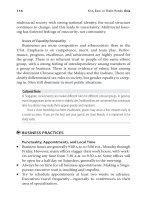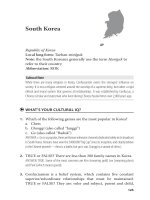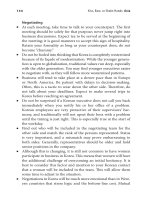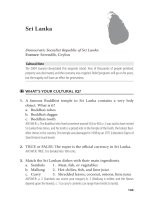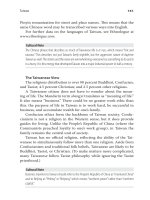How to understand business finance, second edition
Bạn đang xem bản rút gọn của tài liệu. Xem và tải ngay bản đầy đủ của tài liệu tại đây (3.16 MB, 177 trang )
i
How to
Understand
Business
Finance
ii
THIS PAGE IS INTENTIONALLY LEFT BLANK
iii
How to
Understand
Business
Finance
Robert Cinnamon, Brian Helweg-Larsen
and Paul Cinnamon
Second Edition
iv
Publisher’s note
Every possible effort has been made to ensure that the information contained in this book is
accurate at the time of going to press, and the publishers and authors cannot accept
responsibility for any errors or omissions, however caused. No responsibility for loss or
damage occasioned to any person acting, or refraining from action, as a result of the material
in this publication can be accepted by the editor, the publisher or any of the authors.
First published in Great Britain in 2002 by Kogan Page Limited entitled If You’re So Brilliant…
How Come You Don’t Understand Your Accountant?
Reissued in 2005 entitled How Come You Don’t Understand Your Accountant?
Reissued in 2006 entitled How to Understand Business Finance
Second edition 2010
Apart from any fair dealing for the purposes of research or private study, or criticism or review,
as permitted under the Copyright, Designs and Patents Act 1988, this publication may only be
reproduced, stored or transmitted, in any form or by any means, with the prior permission in
writing of the publishers, or in the case of reprographic reproduction in accordance with the
terms and licences issued by the CLA. Enquiries concerning reproduction outside these terms
should be sent to the publishers at the undermentioned addresses:
120 Pentonville Road
London N1 9JN
United Kingdom
www.koganpage.com
525 South 4th Street, #241
Philadelphia PA 19147
USA
4737/23 Ansari Road
Daryaganj
New Delhi 110002
India
© Robert Cinnamon, Brian Helweg-Larsen and Paul Cinnamon, 2002, 2006, 2010
The right of Robert Cinnamon and Brian Helweg-Larsen to be identified as the authors of this
work has been asserted by them in accordance with the Copyright, Designs and Patents Act 1988.
ISBN 978 0 7494 6020 4
E-ISBN 978 0 7494 6021 1
The views expressed in this book are those of the authors, and are not necessarily the same as
those of Times Newspapers Ltd.
British Library Cataloguing-in-Publication Data
A CIP record for this book is available from the British Library.
Library of Congress Cataloging-in-Publication Data
Cinnamon, Robert.
How to understand business finance / Bob Cinnamon, Brian Helweg-Larsen. -- 2nd ed.
p. cm.
ISBN 978-0-7494-6020-4
1. Business enterprises--Finance. 2. Financial statements. I. Helweg-Larsen, Brian. II. Title.
HG4026.C526 2010
658.15--dc22
2009045602
Typeset by Saxon Graphics Ltd, Derby
Printed and bound in India by Replika Press Pvt Ltd
v
Contents
Acknowledgements viii
Introduction 1
1
So why do you want to know more about finance? 3
Learning 5; A tale of two languages 5
2
The business cycle 9
Setting up a company 9; The Moving Balance Sheet® 12;
Creating value 18; Cash and profit 20; Setting up and running
the business – the opening month 25; Profit and loss (P&L)
account 30; The balance sheet 33; Month 2 business cycle 34;
Going to the bank 39; Doing the books 41
3
Where do all the business functions fit in? 45
Sales 45; Marketing 49; Manufacturing 50; Supply chain
management 51; Human resources 52; IT, maintenance and
engineering 52; Research and development 53; Finance 54
vi
Contents
4
Financial planning – the budgets 57
Budgeting 57; Cash flow forecast 58; Avoiding bankruptcy:
how to generate cash 59
5
Measuring business performance – financial
ratios 63
Size 65; P&L account (income statement) analysis 66;
Balance sheet analysis 69
6
Getting finance from the bank 75
Introduction 75; Your relationship with the bank 77;
Purpose of bank finance 78; Is your request viable? 78;
Categories of finance 80; Securing your bank finance 81;
Costs of borrowing 83; Sources of help and support 84;
When should you apply for bank finance? 84;
Maintaining the dialogue 85; Refinancing 86; Summary 87
7
How our investors see us – stock market ratios 89
What accounts do our investors want to see? 89; Shares 90
8
Valuing a company 95
Asset value 95; Multipliers 97; Market capitalisation 98;
Balanced Scorecard 99; Cash flows 100
9
Shareholder value and economic profit 103
Earnings before interest, tax, depreciation and
amortisation (EBITDA) 103; Economic profit 104;
Total shareholder return (TSR) 106
10
The hidden costs – depreciation, amortisation
and tax 109
Depreciation 110; Goodwill 113; Intangible assets 114;
Capitalising costs 114; Taxation 115
11
What must we sell to make a profit? 119
Variable costs 119; Fixed costs 121; Break-even point 122
vii Contents
12
Tools for evaluating projects 127
Payback 128; Discounted cash flow (DCF) 128;
Net present value (NPV) 129; Internal rate of return (IRR) 129;
Terminal values 130; Economic profit 130; Pitfalls 131;
Other factors 131
13
Where is all our cash? Managing working capital 133
Stock (inventories) 133; Debtors 135; Creditors 136;
Write-offs 137; Cash flow implications of working capital 138
Glossary of financial terms 141
viii
Acknowledgements
Writing a book is a daunting task. I must firstly thank Professor
Malcolm McDonald who told us that as a training consultant I
should write books. Next, my colleague Peter Cheverton has
provided an exemplary role model and inspired me to write a book
on something I know a little about – finance for non-financial
managers.
As an engineer by background I attended countless finance
programmes, but it was not until I came across a hands-on
business simulation that I really got to grips with the subject. The
simulation was so effective that not only was I converted, but its
models are now the basis of all my explanations on financial
matters. A big thank you must therefore go to Nigel Downing and
Brian Helweg-Larsen of ProfitAbility® Business Simulations for
providing such an excellent mechanism for conveying in simple
terms the sometimes difficult concepts of finance.
Lastly I thank my publisher Kogan Page for having the faith in
me to produce a worthwhile book.
Robert Cinnamon
ix
Acknowledgements
I would like to thank Gordon Cousins for encouraging me to study,
and then teach finance, and for working with me on the original
ProfitAbility® design; Nigel Downing, for many years of
friendship, working with me on Enterprise ProfitAbility® and
building the business we run today; and my wife Sarah for her
endless patience and total support.
Brian Helweg-Larsen
brian@profitability.com
x
THIS PAGE IS INTENTIONALLY LEFT BLANK
1
Introduction
Many parts of this book build on the business game Enterprise
ProfitAbility®, developed by ProfitAbility® Business Simulations.
You will see a pictorial representation of the finances of a
business in Chapter 2 and it will be referred to throughout the
book. In other sections, examples will be given of six companies
(Ace, Best, Cool, Demon, Excel and First) competing with one
another in this business simulation and so again you can refer to
the picture of the business in Chapter 2 if you find this helpful.
Readers who have a basic understanding of finance can dip in
and out of the book at will. Others may find it helpful to read
Chapter 2 first before moving on to more complex topics.
Inevitably, different elements of finance overlap. So, if you do
not understand a concept mentioned in one part of the book,
check to see if it is explained more fully elsewhere.
2
THIS PAGE IS INTENTIONALLY LEFT BLANK
3
1
So why do you want to know
more about finance?
Ask a group of business people why they need to know about
finance and accounting, or more to the point, why they want to
know about it, and the answers can be rather revealing. Most
people say, ‘I just want to know what they (the accountants) are
talking about.’
This covers a variety of confusions from the abundant use of
jargon (do you know your EBIT from your PBIT?), to the
incomprehension over apparently arbitrary conventions (and yes,
some are just arbitrary conventions… ). The more vigorous the
complaint, the more such comments betray a deeper problem.
Typically, it is a face-saving way of saying that they don’t really
understand the principles of financial and management
accounting. That includes reading a balance sheet – can you? And
knowing how it differs from a profit and loss account – do you?
A variation and sophistication on this first response is, ‘I’d like
to be able to understand why what happens to me, happens to me.’
I have heard a marketing director say, ‘The finance folk are a
team along the corridor who reject my proposals.’
I have heard a production manager ask, ‘Why is it that the CFO
always wins when we are discussing budgets?’
4
How to Understand Business Finance
The general cry of, ‘It isn’t fair…’, when business people are
confronted by their accountants, rises to a deafening climax when
times are tough and cutbacks are required.
After these initial, and often rather bitter, responses, the more
thoughtful will start to say that what they really want is the
confidence to challenge their accountant’s assertions.
The marketing director wants to know why she is always told
that she spends her budget too quickly, and, more importantly,
does she really?
The sales director wants to know why he is told to press
customers to stick to their payment terms, or even to offer discounts
for early payment, when what the customer really wants is extended
credit, and in any case that big sales opportunity is just getting warm.
The operations director is told that he is sitting on too much
stock, yet the salespeople always explode when they run out of
something. What he wants to know is, what’s the problem, and
what’s too much?
The buyer is pressed to ask suppliers for improved terms but
what she would much prefer is for those suppliers to do her some
real favours on developing new products. Who’s right, the buyer or
the accountants, and how could they discuss the pros and the
cons of each approach?
Once you are able to discuss such questions, not only do the
scales fall from the eyes but you are ready to move on to the next
level of sophistication – actively managing your own financials.
If you run your own business, you will (at least in the early
days) often be asking this next question of yourself. Why is it that
when cash flow is good, I don’t worry about it, I don’t even look at
it, but when it’s bad it becomes an emergency demanding instant
attention? At the point of crisis it is pretty difficult to pull anything
out of the hat, and so most minds must turn to cost cutting.
You know it’s short term, you know it will come back to haunt
you, so why don’t you act to avoid such situations in the first
place? One reason might be because you were making handsome
profits at the time. I have stopped counting the number of
businesses that make handsome paper profits, but still go bust.
But for more on that, you must read on…
5
So Why do you Want to Know More about Finance?
Learning
There is little doubt that we learn best through experience and, very
often, from hard experience. If you want to learn about finance there
is no better way than jumping in, feet first, committing yourself to
some stuff, digging your hole, and then fighting to get out of it. I
would guess that the ex-directors of Woolworths now understand
the hard realities of costs and cash flow better than most.
Now, you won’t thank me for that advice if you were to
practise it in your own business, so we’ll aim to do it here, in
someone else’s. People who read books are simply trying to speed
things up, and maybe avoid some of the bear traps. This book aims
to give you that guidance, but also to help you with the experience
of jumping in feet first.
We will explain the concepts, demystify the conventions,
and translate the jargon by walking you through the set-up and
first year’s trading of a real company. But don’t expect it to be
plain sailing.
A tale of two languages
They say that the Brits and the Americans are two peoples divided
by a common language, yet after years of M.A.S.H., Monty Python,
Friends and Fawlty Towers, we seem to understand each other
pretty well. We all know about those words that mark us out – lifts
and elevators, boots and trunks, nappies and diapers, vacations
and holidays – and any confusion caused in communication is
rarely serious, only adding to the diversity of life. Personally, I like
being offered cookies and suspect Americans are just as keen on
being proffered a pint.
It only starts to get worrying when policemen controlling the
crowds of Christmas shoppers on London’s Oxford Street shout
through their loud-hailers ‘Stay on the pavement’, and a dozen
American tourists jump into the road – to these tourists the
pavement is the road, and the sidewalk the pavement.
6
How to Understand Business Finance
But how about when the words move from items of general
discussion to those very specific references to business and
finance? How much upset can you cause by sending an e-mail to a
US colleague asking him or her to send you details of his or her
stocks? Well, as you’ve just asked for a breakdown of his or her
shareholdings, you’ll probably be thought pretty pushy for a start.
And if a US colleague asks you to detail your inventory? I have seen
Brits send back a commentary on their R&D department – surely
he or she means where we invent things, how quaint. Your
colleague wants, of course, to know about your stocks.
Has a Brit CEO ever written to a US subsidiary saying that it
really must cut its expenses, and fast, only to find that it has sold
the factory? Expenses means fixed costs, while we tend to think of
it as the travelling and entertaining budget.
Budgets is another term with all sorts of scope. By budget, the
Brit means a well-thought-out set of targets and limits, whereas
the Americans think of a low-price car rental firm, until you tell
them you mean their operational plan. Asking them to send work
on their budget, or to cut their budget, could have some
interesting repercussions.
When an American asks a Brit what kind of drawings they will
be announcing this year, they don’t want to know about the
sponsorship of the local arts festival, they mean dividends.
And so it goes on – the jargon and the terminology is just
waiting to catch you out, ‘both sides of the pond’. And just to add
a complication, for the uninitiated, what purports to be English
is not what you would find in the Websters – that’s dictionary to
us Brits.
Profit, a simple enough word, can mean a dozen different
things, from gross to net, operating to post-tax, and some people
still think of money, while the accountants would throw their
hands up in horror at such a suggestion.
And on both sides of the Atlantic, accountants often have a
whole series of synonyms for each concept, which they often use
indiscriminately in conversation, causing total confusion to the
layman. Add to this the fact that a number of very simple, wellknown words, such as ‘fixed’ and ‘variable’, are used by
7
So Why do you Want to Know More about Finance?
accountants with very specific technical meanings that have
virtually no relationship to their everyday usage, and you have a
recipe for complete frustration.
And then there are the acronyms – RONA, EBITDA, REM, ROE
et al. (Yes, the third one is a US rock band and not a financial term,
but who’d have dared to ask?)
In discussing the details of financial management we will aim
to explain these terms as we encounter them, and make no
apologies for using them in full where you might prefer to see
plain English – one of the ways of demystifying all this stuff is to
understand the lingo ‘as she is spoke’.
Table 1.1 shows a list of some of the common terms in these
two rather different languages.
8
How to Understand Business Finance
Table 1.1 Common terms in English and US English
English
US English
Other
Accounts
Financial statements
Books
Budget
Business plan
Operational plan
Creditors
Payables
Accounts payable
Debtors
Receivables
Accounts receivable
Depreciation
Amortization
Dividend
Drawings
Equity
Owners’ funds
Factoring
Cash discounting
Fixed costs
Expenses
Funds flow
Cash flow statement
Gearing
Leverage
Gross margin
Gross profit
Indirect costs
Sales, general and
administration (SG&A)
Internal rate of
return (IRR)
DCF yield
Loans
Debt
Net profit
Net income
Profit
Earnings
Burden, overheads
Contribution
Profit and loss account Income statement
Reserves
Retained earnings
Return on sales
Return on revenue
Sales
Revenue
Shares
Stock
Stock
Inventory
Variable cost
Fluctuating cost
Income, top line,
invoice value
Cost of goods sold
(COGS)
9
2
The business cycle
Setting up a company
Businesses differ to such a huge degree that each one is truly
unique, and yet they all go through one simple process in much
the same way. We will call it the business cycle. They produce and
deliver a product or service, they invoice the customer, they pay
their bills, they get paid by their customers, and they do the books.
We are going to set up an imaginary company to demonstrate this
process. The business is represented visually in Figure 2.1.
Let’s take a look at our business. First, we’re going to rent
an industrial unit. This can accommodate up to four
production units and the rent will be the same whether we have
one unit or four.
We’d like to have some cash in this business. In reality this
would be held in a bank account (or in your back pocket if you
were a market trader!) but we’ll have a cash box on our premises
to place this cash in. Do we want to have a lot or only a little
money in this cash box? Already we see a potential argument
brewing between departments, so let’s come back to this
question in a later chapter.
10 How to Understand Business Finance
90 DAYS
60 DAYS
30 DAYS
Figure 2.1 An imaginary business start-up
Next we’ll have an area representing the money owed to us by
customers. As you can see, we may have given our customers 30,
60 or 90 days to pay us and there is a box for each in our premises.
When we deliver goods we invoice our customers and depending
on the payment terms the money they pay should reach us in 30,
60 or 90 days. We can count that money but we can’t have it yet!
Month by month this money will move along, ever closer, until
eventually it will come into the cash box – and only then can we
spend it!
Underneath cash we have a ‘repay’ box. When anything hits
this area we have to pay it from cash. If we don’t have any cash we
must find some or we are bankrupt. Never mind how much profit
you are making, no cash means a bankrupt business.
On one side of this repay box we have the credit we can get
from suppliers after we have been trading for some time and
have established a track record. On the other side we have bank
loans – again, once we have a track record and provided we
11
The Business Cycle
meet the rules laid down by the banks we may be able to borrow
from them.
Lastly, down the right-hand side we have various costs
associated with running the business – rent, wages,
administration overheads etc.
What would you need to start a new business? At the
very minimum you would need:
• An idea – a product or service. What is it you will be
able to charge customers for (ie make a sale and
issue an invoice)?
• Money – this is intentionally vague but you’ll need
some sort of funding.
• A plan – are you going to set up in your back room,
rent an office, DIY or hire staff etc? The better your
plan, the more likely your business is to survive and
succeed.
Let’s say our idea is to go into business installing white burglar
alarms. We’re going to buy in the white burglar alarm system and
we will charge people to install it in their homes.
Next we’ll need some money. Let’s represent this in grey
casino chips – each chip being worth £1,000. We’ll say that as
owners of this company we’ll put in £30,000 to start up the
business. This is represented by 30 grey casino chips which we
will place in cash, as shown in Figure 2.2.
12
How to Understand Business Finance
Figure 2.2 Cash for the business
The Moving Balance Sheet®
We’re now going to invest this £30,000 in the business. We will
want to keep track of where we spend this money; at least, our
accountant will. We’ll start a table recording what we have in the
business and where the money came from. Obviously these two
things should always balance (ie be the same), or else we could
just give up working and ‘cook the books’ whenever we want a bit
of cash to spend – while it lasts. This is shown in Table 2.1.
To install these white burglar alarms we are going to need
some equipment – a van, ladders, tools etc, and we’ll say this will
cost us £5,000. So we’ll buy this equipment and install it in our
industrial unit. To pay for this we take £5,000 from cash and place
it on the equipment. This is a visual representation of the value of
that asset, as shown in Figure 2.3.
13
The Business Cycle
What we have:
Start business
Table 2.1 Moving Balance Sheet® – Step 1
Cash
30
Total
30
Where it came from:
Owners’ funds
30
Total
30
The Moving Balance Sheet® is a registered trade mark of ProfitAbility Business Simulations
Let’s look now at what we have in the business. We have £25,000
cash and the equipment valued at £5,000 making a total of
£30,000. Generally accountants like to value things at what they
cost. That’s the prudent thing to do.
Prudence
You will know that the tax man is very fond of prudence, but
you may not realise that all the accountants ever trained
have had prudence drummed into them until it’s part of their
personalities. Roget’s Thesaurus likens prudence to
14 How to Understand Business Finance
carefulness, sagacity, foresight, economy, caution etc. What
it boils down to in practice is that accountants are trained to
be cautious, risk-averse, and dubious about change.
‘How do you know when you are talking to an extrovert
accountant? They look at your shoes when speaking to you.’
Of course, we all know the exception to this stereotype, but
whatever an accountant’s personality, prudence is not very
exciting. An exceptional young accountant recently told us
he was moving away from extreme prudence, but on a scale
from 1–100, where 1 is extreme prudence, he reckoned he
might now be on 5. Accountants are generally more inclined
to hold you back than push you forward.
Figure 2.3 Value of equipment




